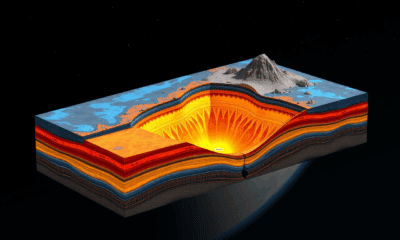While we try to keep things accurate, this content is part of an ongoing experiment and may not always be reliable.
Please double-check important details — we’re not responsible for how the information is used.
Charles Darwin
Uncovering Earth’s Earliest Days: New Research Reveals Secrets of Rocky Planet Formation
New research sheds light on the earliest days of the earth’s formation and potentially calls into question some earlier assumptions in planetary science about the early years of rocky planets. Establishing a direct link between the Earth’s interior dynamics occurring within the first 100 million years of its history and its present-day structure, the work is one of the first in the field to combine fluid mechanics with chemistry to better understand the Earth’s early evolution.

Charles Darwin
The 10,000-mile March Through Fire: How Dinosaurs Evolved to Thrive
Despite Earth’s most devastating mass extinction wiping out over 80% of marine life and half of land species, a group of early reptiles called archosauromorphs not only survived but thrived, venturing across the supposedly lifeless tropics to eventually evolve into the dinosaurs and crocodiles we know today. Armed with a groundbreaking model dubbed TARDIS, researchers have reconstructed their ancient dispersal routes, revealing how these resilient reptiles conquered a hostile, post-apocalyptic Earth.
Ancient DNA
Chemists Recreate a Crucial Step in the Origin of Life
Chemists have demonstrated how RNA (ribonucleic acid) might have replicated itself on early Earth — a key process in the origin of life.
Biotechnology
“Uncovering Ancient Roots: A Gene’s Journey Through Evolution”
A gene that regulates the development of roots in vascular plants is also involved in the organ development of liverworts — land plants so old they don’t even have proper roots. The discovery highlights the fundamental evolutionary dynamic of co-opting, evolving a mechanism first and adopting it for a different purpose later.
-

 Detectors2 months ago
Detectors2 months agoA New Horizon for Vision: How Gold Nanoparticles May Restore People’s Sight
-

 Earth & Climate4 months ago
Earth & Climate4 months agoRetiring Abroad Can Be Lonely Business
-

 Cancer3 months ago
Cancer3 months agoRevolutionizing Quantum Communication: Direct Connections Between Multiple Processors
-

 Agriculture and Food3 months ago
Agriculture and Food3 months ago“A Sustainable Solution: Researchers Create Hybrid Cheese with 25% Pea Protein”
-

 Diseases and Conditions4 months ago
Diseases and Conditions4 months agoReducing Falls Among Elderly Women with Polypharmacy through Exercise Intervention
-

 Albert Einstein4 months ago
Albert Einstein4 months agoHarnessing Water Waves: A Breakthrough in Controlling Floating Objects
-

 Earth & Climate3 months ago
Earth & Climate3 months agoHousehold Electricity Three Times More Expensive Than Upcoming ‘Eco-Friendly’ Aviation E-Fuels, Study Reveals
-

 Chemistry3 months ago
Chemistry3 months ago“Unveiling Hidden Patterns: A New Twist on Interference Phenomena”





























